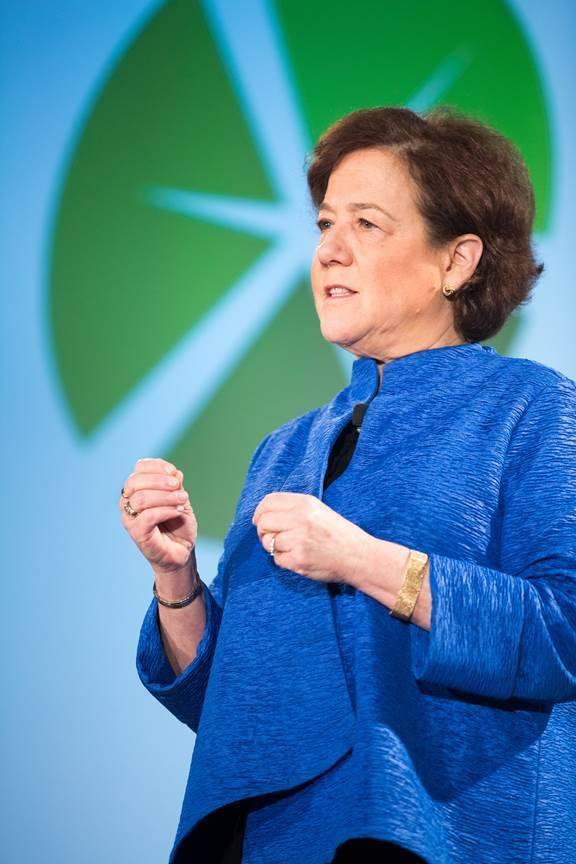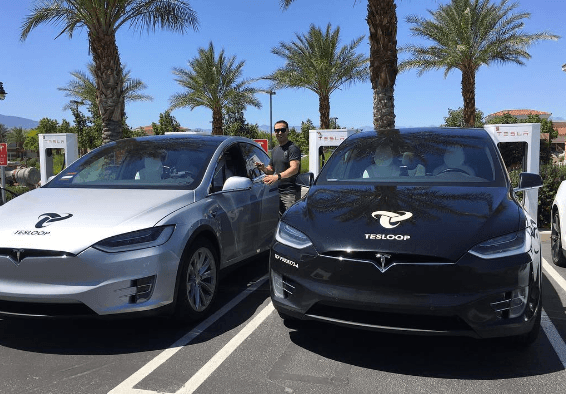GOP Climate Strategy: If You Can't Beat It, Shield It


By Evan Lund
After President Donald Trump's first 100 days in office, the guiding principle behind his policy directives has become abundantly clear: Shield the United States from outside dangers -- both foreign and domestic. As he prepares for a funding showdown over the construction of his infamous border wall, it's apparent that such "shielding" strategies are integral to this administration's desire to protect its people.
In the interest of protecting Americans, it is likely that President Trump might even start to recognize global climate change as a threat. While it's far from the consensus opinion of their party, Republicans in Congress have slowly started to publicly acknowledge the dangers of climate change. However, they also believe President Barack Obama's Clean Power Plan is overly complicated and unrealistic, and they argue that climate change strategy shouldn't necessarily involve increasing regulation.
Considering the Trump administration's deep ties to the fossil fuel industry and the uncertainty of whether or not the U.S. will be able to meet its emissions reduction goals as outlined in the Paris climate accord, it isn't surprising that alternative options are on the table. The option most frequently championed is solar geo-engineering.
Republicans have long touted technologies that harbor the potential to alter the planet's climate system as the best option to reduce global warming. Solar geo-engineering hinges on enhancing Earth's albedo: the amount of solar radiation that reflects off the surface. If adopted, the method would involve injecting metric tons of materials into the atmosphere that could serve as mini-shade devices or nucleation hubs for artificial cloud creation. The result: more reflective clouds, more protective cover, and less incident radiation reaching the ground.
Sulfate particles are one of the many materials that could theoretically perform the job. Phytoplankton and volcanic eruptions naturally produce sulfate aerosols, and these particles can serve as a substrate on which water vapor can condense into clouds that reflect solar radiation.
The best features of geo-engineering are its relatively low cost and immediate temperature-reducing effects. Geo-engineering technologies are estimated to cost only $2 billion to $10 billion a year, low enough for most middle-income countries to afford. Compared to the estimated $200 billion to $2 trillion annual cost of implementing fossil fuel mitigation strategies, the technology offers decreased global warming at 1 percent of the total cost of systemic emissions reduction.
Despite the potential advantages, significant knowledge gaps remain for what could happen if we intentionally manipulate the planet's climate system. Potentially a benefit, the use of aerosols would alter temperatures immediately and only impact the regions where the technology is deployed. However, there are concerns that cooling temperatures in one area of the world may have unpredictable consequences elsewhere, disproportionately affecting regions most vulnerable to extreme weather events. For example, as the Guardian reported, modeling has shown that stratospheric spraying would drastically alter global rainfall, likely causing severe droughts that would threaten the food supply for billions in areas throughout Asia, Africa and South America.
Furthermore, geo-engineering is only a preventative measure -- it reverses none of the pre-existing damage attributable to climate change. Since it has no effect on current greenhouse gas levels, the technique offers no solution to related issues like carbon dioxide elimination or ocean acidification.
But what it might buy us is time, and considering that our current understanding of tipping points reflects an associated risk with rising temperatures, the method should be properly investigated as a legitimate part of our overall strategy.
Recently, the U.S. Global Change Research Program, a consortium of 13 federal agencies involved in climate research, released a report advocating geo-engineering studies be designed to examine the risks and benefits of its large-scale implementation, for the first time ever. Also, a multi-disciplinary team of Harvard researchers is working toward a 2022 field study of the technology. David Keith, a Harvard physicist involved in the study, is quick to defend the science, but also considerate of those who are afraid that the political benefits of solar geo-engineering could outweigh the planetary costs.
Since researchers investigating the technology regard the approach as a supplement, not a substitute, to ongoing climate change measures, some are afraid that President Trump could offer geo-engineering as a short-term solution for our warming planet while shirking our global responsibilities to curb fossil fuel usage. What we must keep in mind is that last year was the warmest year on record and atmospheric carbon dioxide levels are higher today than at any point in the last 3 million years. Let's hope this expanded "shielding" research introduces another viable tool to add to our climate change arsenal for the long run instead of just the cost-effective solution for right now.
Image credit: Pixabay
Evan Lund is a former scientific researcher based in Chicago. He started a research scientist interview series called B-sides and Research that you can visit here.
Ceres Conference 2017: Business Leaders Prove Sustainability is The Bottom Line


By Aaron Pickering
Last week, sustainability leaders from around the world gathered at the Ceres Conference in San Francisco to compare notes and strategize about how to tackle some of our most pressing challenges – from water scarcity and resource depletion to the mounting impacts of climate change. While there are many motivations for companies to play a leading role in addressing these issues, the most important driver cited by attendees is that sustainability can improve the bottom line. Simply put, sustainability is just good business.
To set the stage, experts speaking at the Ceres Conference discussed the critical role of the clean-energy sector in driving economic growth. Most importantly, it is creating jobs. While President Donald Trump has focused on bringing coal miners’ jobs back despite falling coal production and consumption in this country, American jobs in the clean-energy sector have been growing at a rapid rate. In fact, U.S. jobs in solar energy actually overtook those in oil and natural gas extraction for the first time in 2015. Meanwhile, renewable energy is already cheaper in many parts of the world than fossil fuels.
The bottom-line numbers speak for themselves. According to a study published this week by Ceres*, WWF, CDP and Calvert Investments, Fortune 500 companies saved nearly $3.7 billion through their climate and energy commitments in 2016 alone. In fact, seeing the positive boon to their financials, several of these companies continue to push further, with 82 companies in the Fortune 500 having set or committing to set a science-based goal, and 23 aiming to power 100 percent of their operations with renewable energy. Among those companies are Walmart, General Motors, Bank of America, Google, Apple and Facebook.
Another clear takeaway from the Ceres Conference is that the benefits of sustainability commitments are not limited to any one sector. Power producer NRG, for example, has set science-based targets and committed to cutting emissions 50 percent by 2030, and 90 percent by 2050 from a 2014 baseline. Here in San Francisco, NRG’s vice president of sustainability, Bruno Sarda, discussed progress and announced additional goals, including a commitment to helping customers avoid 120 million metric tons of CO2 emissions by 2020.
Meanwhile, IBM is working against a 2020 renewable energy goal and has already seen big results. With more than 3,000 energy conservation and efficiency projects in 2015 alone, the company has avoided the equivalent of 250,000 metric tons of CO2 and has saved nearly $30 million.
This week, investors and sustainability directors are celebrating progress, but also recognizing that more needs to be done. From advocacy in support of state and federal policies that will accelerate renewable energy growth, to continuing to call for the U.S. to stay the course in implementing the Paris Climate Agreement, the companies who are reaping the economic benefits of sustainability have a message for their peers: it’s time to get on board.
Today’s political reality means that it will be more important than ever to lead with the business case for sustainability, setting aside any additional altruistic motivations. The good news is that it’s an easy case to make.
*Cone client
Aaron Pickering is a Vice President in Cone Communications’ Corporate Social Responsibility & Reputation practice with over a decade of experience in strategic public relations, project management and media relations. Aaron advises corporate and nonprofit clients on how to effectively communicate with diverse stakeholders, articulate their vision and build brand awareness. He has worked with companies and organizations across industries and on a range of issues – from labor and human rights to the environment – to tell compelling stories, cultivate media relationships and engage stakeholders to launch strategic public relations campaigns that change minds and drive results. Aaron also teaches as an adjunct professor at The George Washington University.
How Companies Can Support Sustainable Development


Going green and sustainability are becoming industry buzzwords in a world where people are still arguing about climate change. But other than recycling paper waste and going digital, many companies don’t even know where to start when it comes to sustainability.
Green buildings, those designed to be sustainable from the very beginning of their planning, are an important way to turn these monoliths of construction into green, sustainable monuments that can reduce our footprint on the planet. How can green buildings help companies reach their sustainability goals? And how can companies then look beyond their own four walls to make a difference in their communities?
Renewable energy
Our primary sources of power are dumping thousands of tons of carbon dioxide into the atmosphere every year — burning coal and natural gas resources that are non-renewable and are swiftly running out. This is the primary reason behind the push toward clean and renewable energy. How can this be applied to green buildings?- Solar and wind power: Depending on the location of the business, solar and/or wind power can be incorporated directly into the building architecture or built on the grounds. Both of these types of energy are renewable and after the initial investment for the equipment, these forms of renewable energy tend to pay for themselves.
- Combinations: Companies that cannot afford to fully power their buildings with renewable energy commonly utilize a combination of both renewable energy and fossil fuels.
- Green energy purchasing: In many areas, companies can purchase green energy from their service provider for a slightly higher cost than traditional fossil fuel energy.
Sustainable infrastructure
The developed world already has a fairly well established infrastructure, but it wasn’t designed to be sustainable or to withstand the ravages of climate change. We’ve already seen this impact in California, with the fracturing of the Oroville Dam spillway in March as massive rains after nearly two years of extreme drought proved to be more than the infrastructure could handle.While this might not seem like a problem for the individual CEO or business owner, it’s important to remember how all of these things are connected. A business can’t function without the electricity, roads, and other essentials provided by city, state and national infrastructure.
Socially responsible investing is one way that every business can help create the sustainable infrastructure we will need moving forward. This is designed to provide financial gains for the company while still creating a positive impact on society.
Economic growth
Going green is all well and good, but it’s pointless if you can’t pair that environmental sustainability with economic growth.Renewable energy is already creating jobs and with that it is encouraging economic growth — one report found that the renewable energy industry is creating jobs 12 times faster than the rest of the economy. The trick is finding the balance between sustainability and economic growth. Growing a business might seem counterintuitive in terms of sustainability, which is why that balance is so important.
The key is to ask yourself: How can we continue to foster economic growth while still maintaining environmental sustainability?
Communities
A business is only as strong as the community in which it operates. When it comes to sustainability, business owners should look beyond their own walls and into the communities around them. In many cases, this is as simple as giving back to the community and investing in things like:- Creating jobs to improve individual family income
- Improving local education
- Creating ways to support healthy lifestyles for community members
- Investing in expanded local housing to build communities.
Global partnerships
Green building and fostering sustainable development is not something that can be completed passively— it requires active and consistent action from individuals and businesses around the world. Global sustainability partnerships between businesses of all sizes will be the next most important step in creating a sustainable world.The world is changing, and it’s our responsibility as one of the species living on this planet to do everything in our power to reduce our environmental impact and promote global sustainability. Green building, and creating clean and renewable communities and businesses from the ground up, is the first step in protecting our planet and ensuring that it’s just as beautiful for the generations to come.
Image via: Pexels
Britain’s hairdressing sector has potential to drive sustainability in communities


3p Weekend: These Companies Want You to Eat Bugs


With a busy week behind you and the weekend within reach, there’s no shame in taking things a bit easy on Friday afternoon. With this in mind, every Friday TriplePundit will give you a fun, easy read on a topic you care about. So, take a break from those endless email threads, and spend five minutes catching up on the latest trends in sustainability and business.
The global population is expect to reach 9.7 billion people by 2050. Experts the world over insist we must completely revamp our food system if we hope to feed the world's growing population.
Some say organic agriculture is the answer. Others tout the benefits of genetically-modified (GMO) crops. But stakeholder groups including the U.N. Food and Agriculture Organization are hoping a more unlikely solution will take off: bugs.
While the concept of eating bugs turns up noses in the Western world, we're basically the only ones. Insects are an everyday snack or a traditional delicacy in countries across Asia, Africa and South America. And if edible entomology were explored to its full potential, it could offer sustainable protein to billions while taking pressure off the world's oceans and animal agriculture, says the FAO.
It's easy to see what organizations like the FAO see in insect protein: Insects require far less water, food and land to produce protein. But, all benefits aside, Westerners remain wary of bugs in their food. These startup companies are out to change that -- and they hope their quirky recipes and innovative business models can bring insect protein mainstream.
1. Poquitos
Seattle restaurant Poquitos serves up tacos, tostadas and other traditional Mexican fare. But the menu item generating the most buzz is chapulines: a species of grasshopper that is popular in several regions across Mexico.
The dish became an unlikely hit at Poquitos' flagship location at the popular Pike Street Market in downtown Seattle. But the crunchy snack made the international press after the company opened a stand at Safeco Field, home of the Seattle Mariners.
Fans couldn't get enough. They ordered more than 900 servings within three games, and the stand had to limit the quantities it served.
2. Exo
Exo founders Greg Sewitz and Gabi Lewis concocted their first batch of cricket protein powder in their dorm room at Brown University. After launching a Kickstarter campaign and blowing past their goal within 72 hours, the pair was hooked.
Their startup now counts rapper Nas and lifestyle guru Tim Ferriss among its investors, Fortune reported last year. It also raised nearly $6 million in seed and Series A financing in under two years -- and it's now positioned as a clear leader in the burgeoning edible insect space with its cricket-based protein bars.
3. Chapul
Entrepreneur Pat Crowley introduced America to his insect protein startup, Chapul, with a 2014 appearance on ABC's "Shark Tank." The concept earned him $50,000 from billionaire investor and Dallas Mavericks owner Mark Cuban.
The company's protein bars made from cricket flour can now be found in some mainstream grocers like Publix. And Fortune gave it a rave review last year, predicting four months into the year that the company would rake in $1 million in revenue for 2016.
4. Aspire Food Group
If you've ever run across insect protein at popular Austin, Texas, events like SXSW or SXSW Eco, chances are Aspire Food Group was involved. The company is a pioneer in the edible insect space, and is looking to leverage the unusual protein to combat food insecurity worldwide.
The Texas startup now operates farms in the United States and Ghana. In the U.S., crickets fed a USDA organic diet are transformed into accessible and tasty products that Aspire hopes will normalize insect consumption in the Western world. In Ghana, where the consumption of insects such as palm weevils is far more common, Aspire seeks to empower peri-rural farmers to make a living growing weevils locally and sustainably.
5. Bitty Foods
If foodie trends of years past have taught us anything, it's that cute packaging and intriguing recipes can make all the difference. And San Francisco startup Bitty Foods is testing this theory in the insect protein space.
Co-founders Leslie Ziegler and Megan Miller are out to banish the "ick" factor around buggy snacks with a versatile cricket flour and air-puffed crisps that are basically the PopChips of the insect world. Those who are wary about snacking on bugs may be drawn in by unique flavors like salsa verde, spicy mole and baja ranchero.
“My vision is that we’re going to boost the protein content of all the staple foods that we eat,” cofounder Megan Miller told The New York Times in 2014. “And we’re going to need a really sustainable and plentiful protein source to do that with.”
6. Chirps
Chirps, the brainchild of three female Harvard University grads, is another startup looking to make insect protein hip. The founding trio first got their start in the famed MassChallenge accelerator and quickly grew their business to a national profile.
The company now offers classic snacks like chips and cookies infused with cricket protein. Seriously, you can now buy chocolate chip cookies made with crickets. If that's not incentive enough to give insect protein a try, we don't know what is.
7. Entomo Farms
Entomo Farms sells its own line of insect products including protein powder, toasted cricket snacks and even pet treats. But it also supplies the cricket flour behind both Exo and Chapul's protein bars, Fortune reported last year.
Founded by two brothers, the company operated three 20,000-square-foot barns as of last year. They intend to raise 90 million crickets in hopes of attracting a lucrative Series A round, the magazine reported.
8. Anty Gin
If you thought the rest of these concepts were whacky, hang on to your hats. In partnership with the experimental Copenhagen-based Nordic Food Lab, the storied Cambridge Distillery released a new gin last year with a secret ingredient: ants.
Okay, this will definitely sound strange, but stay with us: The red wood ant, native to forests across the Northern Hemisphere, produces formic acid in its abdomen to deter predators. "Luckily for us," the partners wrote on their website, "these very compounds hold great delicious potential. Formic acid (the simplest organic carboxylic acid, with the chemical formula HCOOH) is a very reactive compound in alcohol, serving as an agent for producing various aromatic esters."
Each bottle of Anty Gin contains the essence of approximately 62 wood ants. Cambridge Distillery insists this odd ingredient creates a flavor never before seen in the gin industry -- and, as the world's first gin tailor, they would know.
Image credit: Flickr/Ben Murphy Online
Report: Almost Half of Fortune 500s Set Climate Change, Clean Energy Targets


Climate change and clean energy targets are an important part of a company’s environmental sustainability program. The good news is that more and more companies are recognizing this and setting goals.
Almost half of Fortune 500 companies (48 percent) have at least one climate change or clean-energy target on the books, an increase from years past. These findings and more comprise a joint report from the World Wildlife Fund, Calvert Investments, CDP and Ceres entitled Power Forward 3.0: How the largest US companies are capturing business value while addressing climate change.
The cohort of researchers insist emissions-reduction projects save money: Almost 80,000 projects employed by 190 companies netted almost $3.7 billion in savings last year alone. The annual emissions reductions from these projects equated to taking 45 coal-fired power plants offline for one year.
Both the largest and smallest Fortune 500 companies are leading the way. The Fortune 100, the largest companies in the index, continue to be the leaders: 63 percent of them have set one or more clean energy targets. Forty-four percent of the smallest 100 companies in the index have set goals in one or more categories, a 19 percent increase from 2014. Companies within the consumer staples sector have the largest amount of companies with targets, while the energy sector has the smallest amount.
Corporate goals are more ambitious than ever
One of the most significant new trends among the Fortune 500 is the increasing ambitiousness of the goals, with more companies moving to create science-based targets and set 100 renewable energy goals, the cohort representing NGOs and an investment body concluded.As of January, 210 companies set targets through the Science Based Targets initiative, which galvanizes corporate goal-setting based on climate science. These leaders include American multinationals like Procter & Gamble, General Mills and Kellogg.
The Science Based Targets initiative is a collaboration between the WWF, CDP, World Resources Institute and the United Nations Global Compact, in partnership with the We Mean Business Coalition. For what it's worth, 72 percent of the Fortune 500 (14 percent) reported to either CDP or the Science Based Targets initiative that they intend to adopt a decidedly science-based target within a few years.
For its part, consumer packaged goods giant P&G is committed to reducing the emissions from operations by 30 percent by 2020 from a 2010 base-year, according to a Science Based Targets case study. During this time frame, P&G will address the main source of emissions across its value chain, which include targets related to cold-water washing, post-consumer plastic use and zero-deforestation policies. Before setting the target, the company had already committed to sourcing 30 percent of its energy from renewables.
And P&G isn't alone. Renewable energy is looking attractive to a growing number of companies. Almost two dozen Fortune 500s committed to power all of their corporate operations with 100 percent renewable energy, mainly wind and solar. Last year, only a handful of companies made such a commitment. Some of the companies pledged to 100 percent renewables are Walmart, Bank of America, Google and Facebook.
A goal to source only renewable energy is a “signal of high ambition,” the most recent joint report states. And company size is a “key indicator of the likelihood” of setting such a target: 14 of the targets come from companies in the Fortune 100, with four in the Fortune 101-200, three in the Fortune 201-300, and just two in the Fortune 301-400. There are no companies in the bottom quintile of the Fortune 500 with a 100 percent renewable energy target. All 23 companies with such a goal are in four sectors: information technology, financials, consumer staples, and health care.
While only a fraction of Fortune 500 companies have adopted such an ambitious goal, more than double the amount (53 companies) have set a target to buy or invest in renewables such as wind and solar. Companies are using various approaches to meet their targets, including unbundled renewable energy certificates (RECs) purchases, onsite installations (mainly solar), and larger-scale, off-site purchases. Since the Power Forward 2.0 report, 33 companies signed almost seven gigawatts (GW) in new, direct and off-site corporate renewable energy contracts, with most of them in the Fortune 500.
Image credit: Flickr/reynermedia
Trump's Tax Plan Could Be a Boon to Small Business, But Will Congress Pass It?


Small businesses have been lobbying hard for changes to the U.S. tax code, which many argue penalizes successful pass-through entities at an unnecessarily high tax rate. That’s because under the current tax code, business owners of sole proprietorships, partnerships, limited liability corporations, and S Corporations assume the profits and loses of their businesses and as a result pay at the rate of individual taxpayers.
The Donald Trump administration’s newly proposed tax changes would presumably do away with that problem. Treasury Secretary Steven Mnuchin said business owners could see their taxes slashed from as high as 39.6 percent to 15 percent, allowing proprietors to invest more in their businesses, instead of Uncle Sam’s tax system.
And the tax proposal suggests similar changes to the rate that large corporations pay, as well. If Trump’s plan were to pass Congress, corporations could see their rate drop 20 percent (from 35 to 15 percent) -- an irresistible lure the administration hopes will bring back businesses that moved their headquarters to other countries with lower tax rates.The proposal would also impose a one-time 10 percent tax on the foreign revenue of companies that choose to return to the U.S.
But the most talked-about feature of the president’s plan is its philosophic change when it comes to personal income taxes.
Under the current code, taxpayers have the option to claim a personal exemption of $6,500 per person/$12,600 couple, or pick from a buffet of tax deductions that are meant to apply to personal circumstance.
Under the administration’s proposal, deductions like claiming your home office, health care and student loan interest – all commonly used deductions – would be eliminated.
Other deductions that could meet their end under the new strategy include:
- Employee expenses not reimbursed by the employer
- Transportation expenses
- State and local income taxes
- Other education costs
- Alimony
- Gambling debt
- Items like vehicles and household items lost in theft
Trump said the new tax plan would raise the standard deduction considerably. (The administration initially declined to say the proposed rate, but analysts are speculating that it would double the individual/couple deduction rate to incentivize taxpayers to take the standard deduction instead of claiming the itemized deductions still available.)
The administration also said that homeowner deductions like mortgage insurance would stay in place.
Equally significant is the restructuring of tax brackets. The administration proposed dropping the number of brackets from seven to three in a continuing effort to simplify the tax code.
There’s been a considerable amount of back-and-forth criticism of the tax plan in the past few days, with experts ranging from private analysts to former treasury secretaries weighing in on whether the plan would help or hinder the economy.
Former Treasury Secretary Larry Summers, who served under the Bill Clinton and Barack Obama administrations, blasted the proposal for what he called a lack of transparency and detail.
“Most presidential campaigns during the primaries, when they put out a tax plan, they put out more than one page. They put out some analysis, some models, some careful articulation of the proposal and estimate its effects,” Summers told CNBC, noting that the single-page proposal amounted to a list of bulleted items with no factual explanation or analysis as to why the administration felt the steps would work.
Financial analysts who tried to look past this dearth of information brought up that the true beneficiaries of his proposal would include Trump himself. The Trump Corp. is a pass-through entity and would stand to benefit.
The director of federal tax policy for the nonprofit Center on Budget and Policy Priorities, Chuck Marr, reminded readers in a February policy paper that Trump promised during his presidential campaign that his future plan would “have absolutely no tax cut for the upper class.”
In fact, Marr said, by conservative estimates the lower tax rate would give “400 highest-income households a tax break of about $9 million” a year. That includes Trump, who never divested fully from his business dealings. Other analysts estimate his total gains to be somewhere around $65 million a year.
But all of this criticism may be for naught when the plan reaches Congress. Although House Speaker Paul Ryan said he sees the proposal as being “along the same lines” of what House Republicans would support, many who support slimming the federal deficit will be skeptical of the plan’s rationale.
That’s because the substantial tax breaks -- which are, to some degree or another, across the economic spectrum -- will translate to reduced revenue for the federal government and a bigger federal deficit.
The Committee for a Responsible Federal Budget estimates that the changes Trump proposed would cost the government between $3 trillion and $7 trillion over the next 10 years – a conversation-stopper for members of his party who want to see the deficit slashed.
Mnuchin said the administration believes that increased money in the pockets of business owners will mean a more vibrant economy, and in turn, more money to pay off the deficit. He said the “goal” is to boost sustainable economic growth by “3 percent or higher." Some analysts, however, believe that is an unrealistic goal for an economy that has hovered under 3 percent growth for the last five years. And the risk is, say those who are sounding the warning bell, is that unsustainable growth, such as Mnuchin proposes, would only balloon the deficit further.
But until the Trump administration actually submits a detailed, finalized proposal with facts and figures, all of this is speculation. And it hasn’t missed the attention of Trump’s more ardent critics as other ambitious proposals that piqued the ire of both Republicans and Democrats in Congress failed to show a common-sense path forward have been a hallmark of Trump’s first 100 days.
The question is whether he can turn this tax proposal into a concrete strategy that will help small businesses, sustain economic growth and rally a divided Congress on his behalf. Building a sensible tax structure that helps the economic engine of the country grow may not be as hard as it sounds. But getting Congress build on consensus instead of differences and pass a plan that works for all concerned, may be the real challenge.
Wikimedia image: Daniel Schwen
Border Wall Could Start a Flood of Worries in the U.S. and Mexico


U.S. President Donald Trump’s proposed border wall poses a bevy of problems that stretch beyond the question of who will pay for it. Those challenges include rising labor costs, the loss of commerce suffered by local businesses on both sides of the border, and even threats of a land grab to make way for the wall's construction -- an affront to U.S. citizens, especially those who held title to their properties for generations.
Now the wall has hit another snag. As NPR reported this week, some portions of the wall could violate a treaty that was negotiated between the U.S. and Mexico back in 1970.
The problem is a boundary treaty, to which both countries agreed in order to settle questions over how the Rio Grande and Colorado Rivers demarcated much of the 1,954-mile border. Some walls and fencing that were built during previous American presidential administrations have already been linked to flooding and property damage. Now, Mexican officials have had enough.
In 2008, floodwaters that built up against steel fencing crested and damaged parts of the Organ Pipe Cactus National Monument in Arizona, inundating the border hamlet of Lukeville. Walls exacerbated flooding in the border cities of Nogales in Mexico and Arizona, as garbage that accumulated due to rising waters eventually caused a section of the fence to collapse, damaging dozens of homes. Engineers who work on both sides of the border have said that additional walls constructed within floodplains could in effect become dams, wreaking havoc in both rural areas and border towns alike when sudden rains occur.
Key to deciding whether this wall can continue to expand is the International Boundary and Water Commission (IBWC), which is tasked with settling any disputes over construction projects that could have an impact on the flow of the Rio Grande or its floodwaters. Much of IWBC’s work is rather mundane, with much of its work concerning aquifers, levees and the repair of infrastructure along this long desert frontier.
But that scope of work could suddenly change. Engineers working in Mexico have said that some of the wall’s proposed construction could violate this 47-year-old treaty. Both Mexican and American officials on the IWBC must agree to construction plans by either side if they could potentially affect the flow of the Rio Grande. If these disputes cannot be settled by the IWBC, then such cases could end up in an international court.
In the past, there have been conflicts over whether sections of a border fence could affect the flow of floodwaters; and despite protests from Mexico, some projects have progressed anyway. Such violations were overlooked, largely because the previous two presidential administrations were seen as relatively conciliatory toward Mexico.
But Trump’s tenor has changed the dynamic between the two countries. Threats that a wall along the Rio Grande would be built on the Mexican shore of the river, clearly a violation of the country’s sovereignty, have not helped the Trump administration’s case. Mexican officials are reportedly ready to fight back against any projects their country feels could cause environmental damage on its side of the border. They are also confident that Mexico would emerge victorious if such a case between the U.S. and Mexico goes to an international tribunal.
Of course, tracking the progress of Trump’s wall is akin to watching a ping-pong match. On Thursday the president, who often boasts about his negotiating skills, negotiated out of his demands that Congress provide funds for the project – before such talks even began. But the only thing we can predict about this president is that he has proven to be as entirely unpredictable in the White House as he was on the campaign trail. Local businesses and environmental organizations can take a deep breath for now, but do not be surprised if somehow this debate festers yet again, even as engineers and environmentalists on both sides of the border have made it clear that the environmental risks of such a project outweigh the supposed security benefits.
Image credit: U.S. Customs and Border Protection/Flickr
Patagonia Embraces Natural Dyes for Clean Color Collection


Using red onion skins to dye Easter eggs is a longstanding homemakers trick. Some may even have dyed upholstery or clothing with galls, bulbous growths that can be found on oak trees throughout California.
The venerable outdoor clothing company Patagonia is taking these natural dying techniques even further with its Clean Color Collection for both men and women. If you’re looking for bright primary, secondary or neon colors, don’t bother with this product line. The tones are muted, soft and earthy – and why wouldn’t they be? After all, they do come directly from natural sources.
Sage- and tan-hued tones result from the use of mulberry and the end result of mulberry leaves, silkworm excrement. Pinks are the result of both prickly pear and pomegranate. Citrus peels, palmetto leaves and cochineal insects (which was used in some Starbucks products until vegetarians pitched a fit) are amongst the other ingredients Patagonia touts for this collection. For the darker shirts and shorts, Patagonia uses other sources of bio-waste like agricultural residue.
For the most part, the collection is simple, with patterns limited to color-blocking and a few plaid designs. Organic cotton is the preferred fiber, with a small portion of the clothing line comprised of polyester derived from alternative sources.
Patagonia is sourcing the colors from California-based Swisstex, a company that says its ethos does not stop with its dyes, which are supposedly more natural and sustainable alternatives to chemically-derived dyes. Swisstex also insists that it minimizes its water and carbon footprint across its entire operations.
While critics of the global apparel industry tend to focus on the copious amounts of fiber consumed to meet the growing demand for cheap clothing, the textile dyeing process marks the fashion industry with a huge environmental footprint. For years, many dyeing factories have followed wasteful water consumption practices, with dye-to-water ratios of 1-to-30 not uncommon. In countries such as India and China, these dyeing facilities are not only notorious for exhausting local water supplies, but have also been accused of dumping their wastewater products into local streams, rivers and ponds.
Patagonia’s Clean Color Collection is just the latest example of how the company stands out from its peers in the outdoor clothing and gear industry. For example, Patagonia has long encouraged its customers to repair instead of quickly replacing its clothes. The company has experimented with alternatives to neoprene, such as natural rubber, for its wetsuits. And while other retailers were reluctant to take a stand over the recent public lands controversy, Patagonia withdrew from the annual Outdoor Retailer trade show in Utah – which nudged that organization to leave the state entirely. The company is now threatening to sue the Donald Trump administration over its latest executive order relating to public lands.
To date, Patagonia has not made it clear whether this Clean Color Collection is a one-off product launch or will become a regular product offering. At the moment, the tanks, shirts, hoodies and hiking pants for both men and women range in price from $39 to $119.
Image credit: Patagonia
Tesloop Promises Easy City-to-City Travel in a Tesla


Maybe you are curious about driving a Tesla, but are not quite ready to plunk down the cash for one. You could have signed up for the Model 3 waiting list, but last time you checked, your car may not arrive until 2022. So what is an electric car maven and Tesla fan to do?
Tesloop offers a happy medium: inter-city travel between cities in California. Think of this as a limousine service meets a ridesharing app like Uber or Lyft, complete with a concierge to make your ride even more enjoyable. Organic juices and snacks are also available on all of these trips. And in a nod to the Instagram and Snapchat generation, the company is quick to realize that its passengers can be its best marketers: Rides are equipped with Wi-Fi and device chargers so users can easily document or snap their trips.
For now Tesloop, which is not affiliated with Tesla Motors, only operates in Southern California -- though it's optimized routes enough to offer seat sales on occasion. For a while, the service offered rides to Las Vegas, but that route has been temporarily discontinued. The company suggested San Francisco and Santa Barbara as locations, which at first threw me off. When I tried to book a trip between my town and the Bay Area or Los Angeles, I kept receiving an apologetic message saying that was not possible – I should not have been surprised, as Paul McCartney makes more appearances in Fresno than Teslas, but finally, I figured out the locations, and played around with the scheduler.
Let’s say you’re moored somewhere around Palm Springs and you wish to escape the desert for a day at the beach in Santa Monica. Planning a trip on Tesloop is similar to booking a seat on a flight, only with less pages to go through and far fewer disclosures that none of us read anyway. I found out that if I want to go to Santa Monica this coming Sunday, there are two pick-up times from a Panera Bread location at Palm Desert, at 7:45 and 10:16 a.m. The trip to a Starbucks on Venice Boulevard takes about two hours and 20 minutes, give or take the unpredictable Southland traffic and other horrors that could occur on Interstate 10. Yes, the locations at which you must meet your Tesla/Tesloop pilot seem random; but the company says much of its trips progress on autopilot, and the goal is to move people along highways as quickly as possible.
If you are content sitting all the way back in one of the rear folding seats of a Model S, that trip from the desert to the sea will set you back $69. Should you insist on riding shotgun or in the more comfortable middle passenger seats, that seat will cost another $10 – which is not bad for two hours of entertainment or if you really want to impress that date. The company asks that you show up about 10 minutes ahead of time so that the Tesla concierge and pilot (driver) can get you sorted before your trip.
Tesloop says its mission covers many bases. First, the company vows to “make the travel experience great again,” a term that may need some tweaking considering the demographics lured to this service. Then again, considering the recent shenanigans at United Airlines, the company has a point.
Tesloop’s founders also want to show that zero-carbon travel has its perks. To that end, the company aims to expand its services to just about anywhere along Tesla’s supercharger network over the next two years.
Tesloop sees the largest opportunity in circumventing regional jets that fly between cities less than 250 miles apart. As any weary business traveler knows, the hassle of airport security, long waits in a tiny airport and scant legroom in a puddle jumper lose any appeal rather quickly. Tesloop, however, believes it can groom a market share along these routes. And the company is spot on, when considering the time consumed driving to and from airports and waiting in airport terminal lines.
And finally, noting that the average Tesla is only operated 5 to 10 percent of the time, Tesloop wants to maximize the amount of time these cars are schlepping people on the roads. In the company’s estimation, a Tesla can be driven 16 hours a day, charged six hours daily and in turn could drive up to 30,000 miles a month. Such logic was behind the carsharing sites of yesterday like RelayRides, before Uber and Lyft rendered those services obsolete.
My gut reaction to Tesloop’s vow to keep cars on the road as much as possible was, “whoa, these cars can only last so long before they finally peter out.” But the company notes that the combination of Tesla’s car warranties, along with their superior driving performance, makes its business plan a watertight one.
In any event, for those of us who salivate at the thought of a Tesla but are not financially or intellectually ready to commit, reserving a Tesloop trip for a weekend drive (or even working as a Tesloop pilot) could be yet another step to the dream -- and it may also help Tesla's popularity surge even more and even grow the electric vehicle segment at large.
Image credit: Tesloop/Instagram